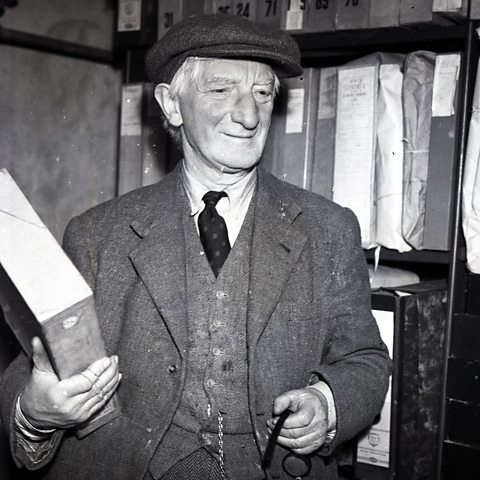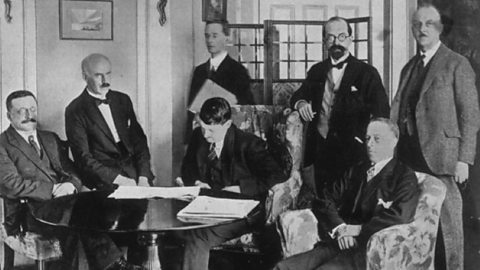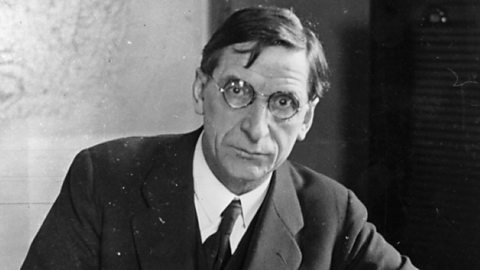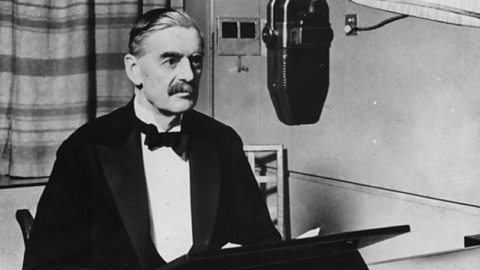Labour wins power

In May 1945, World War Two ended in Europe.
Two months later, the Labour Party won a landslide victory in the British general election.
Voters were attracted by Labour’s promises of jobs for all, government ownership of industry and the introduction of a welfare stateA system in which the government provides services that are designed to protect their citizens’ health, and give them support during times of need. These services might include a pension scheme, benefits and a health service, such as the NHS..
The new Prime Minister was Clement Attlee.
The new government faced a very difficult situation:
- The country was almost broke.
- Poverty was widespread.
- Most of the goods being made in Britain were being sold abroad so that food could be importTo purchase (buy) goods from abroad and bring them into a country. The goods are known as imports..
- Coal, bread and potato supplies had almost run out.
- In 1946, bread rationingThe system of limiting people's access to things that were difficult to get during World War Two. People were allowed limited amounts of food, clothing and soap during the war. This meant that there would be enough goods for everyone. was introduced.
- In 1947, potatoes were also rationed.
As a result, the immediate post-war period in Britain was known as the ‘age of austerityA period of difficult economic conditions as the government reduces spending.’.

Nationalisation
Labour introduced a policy of nationalisationWhen the state takes ownership and control of Industries or companies..
It was implemented as follows:
- 1947: coal mines and electricity.
- 1948: railways.
- 1949: iron and steel.
The government also began to build houses to eliminate slum housingHouses that are of poor quality and tightly packed together. and repair the damage caused by the The BlitzAn aerial bombing campaign directed at large towns and cities and carried out by the German air force (the Luftwaffe) during World War Two..
680,000 houses were built between 1947 and 1950.
Unionist reaction to Labour's victory
unionistA person who believes the union between Britain and Northern Ireland should continue. were worried by the Labour Party becoming the government in Britain because in the past, Labour had been strongly critical of Northern Ireland.
Unionists were also worried about some of Labour’s key policies:
- nationalisationWhen the state takes ownership and control of Industries or companies. of industries.
- The welfare stateA system in which the government provides services that are designed to protect their citizens’ health, and give them support during times of need. These services might include a pension scheme, benefits and a health service, such as the NHS., which would be costly.
- Had previously questioned the ability and fairness of the Stormont government.
- Had been opposed to partition/partitionedThe division of a country into two regions. and unionists feared they might be forced into a united Ireland.
In the end, however, unionists felt that Northern Ireland’s best chance of staying economically stable was to maintain its close relationship with Great Britain.
The Welfare State

In 1942, a government committee had been set up to investigate the extent of poverty in Britain.
Chaired by Sir William Beveridge, its job was to suggest ways of improving the lives of the British public.
The Beveridge Report 1942 recommended a government-run benefitsMoney to support people eg due to unemployment, illness or disability. system designed to support people from the 'cradle-to-grave'.
Benefits would be available to the unemployed, the sick, the retired and the widowed.

The NHS
In addition to Beveridge's proposals, Westminster also planned to improve education, housing and working conditions and to create a national health service.
Workers would pay a compulsory weekly contribution to the state to finance the schemes.
It was against this background that Clement Attlee, and his Minister of Health, Aneurin Bevan, made significant changes to welfare in Britain and Northern Ireland between 1945 and 1951.
One of the key elements of their reforms was the introduction in July 1948 of the National Health Service (NHS).

Their reforms would create what became known as the welfare stateA system in which the government provides services that are designed to protect their citizens’ health, and give them support during times of need. These services might include a pension scheme, benefits and a health service, such as the NHS..
Question
Why was the Welfare State introduced in Northern Ireland?
The destruction caused by the The BlitzAn aerial bombing campaign directed at large towns and cities and carried out by the German air force (the Luftwaffe) during World War Two. had exposed inadequate housing, widespread poverty and poor health amongst Northern Ireland’s working class.
Reaction to the Welfare State
Most people welcomed the welfare stateA system in which the government provides services that are designed to protect their citizens’ health, and give them support during times of need. These services might include a pension scheme, benefits and a health service, such as the NHS., particularly the less well-off because it helped with many of their housing, education and health problems.
However, some people initially objected to it.
- The wealthy classes were displeased when the government nationalisationWhen the state takes ownership and control of Industries or companies. coal mines, railways, industries, electricity provision and the Bank of England to help achieve its policies.
- Small business owners feared nationalisation would be extended to more areas and affect the ownership of their firms.
- Many doctors believed that their professional independence would be undermined and they would be turned into civil servants. (In the end, however, the NHS was joined by 90 per cent of doctors. It was hugely successful, even if it was massively expensive, and it greatly benefited public health in the UK.)
- The middle class was worried taxes would be increased to fund the reforms.
- Others thought the Welfare State would encourage people to live off the state rather than seek employment.
In Northern Ireland
Despite the need for massive reforms in health care and housing, many in Northern Ireland’s middle classes and medical profession feared what Labour’s policies might mean for them.
- They were conservativeNot in favour of change, cautious. and did not favour rapid change.
- They disliked Northern Ireland’s growing dependence on the TreasuryHM Treasury is the government’s economic and finance ministry. It controls public spending and is responsible for the country's economic well-being., and were concerned that Stormont would have to pay for the cost of welfare.
- Stormont feared the loss of power to a centralising socialistSomeone who believes that society should be classless and that all property and wealth should be owned by the whole community and not by individuals. government and wondered how it was to finance such reforms.
The less well-off welcomed the welfare stateA system in which the government provides services that are designed to protect their citizens’ health, and give them support during times of need. These services might include a pension scheme, benefits and a health service, such as the NHS., whilst nationalistPeople who believe their country should be independent from other nations. For example, Irish nationalists, who want Ireland to be fully independent of Britain. were happy as they stood to benefit more from government plans to improve housing and health.
They also saw a Labour government as potentially more sympathetic to their situation.
In the end, Labour showed its gratitude for Northern Ireland’s war effort by helping to cover the costs of the introduction of the Welfare State.
As a result, improvements were effected in a range of areas.
The impact of the Welfare State in Northern Ireland
The welfare stateA system in which the government provides services that are designed to protect their citizens’ health, and give them support during times of need. These services might include a pension scheme, benefits and a health service, such as the NHS. was very successful and brought massive benefits for the people of Northern Ireland.
Local welfare standards, which had been worse than those in Britain, were now the same, and Northern Ireland citizens were better off than their counterparts in Éire.
The Welfare State provided three major improvements: the NHS, benefitsMoney to support people eg due to unemployment, illness or disability. and housing.
The National Health Service (NHS) in Northern Ireland
When the NHS was rolled out in 1948, people in Northern Ireland benefitted from:
- Better organised hospitals.
- Free consultations with doctors.
- Free prescriptions.
- The introduction of free dental and eye treatments (although later some charges were introduced).
- A new tuberculosis (TB)Historically called consumption, TB is an airborne infectious disease that usually infects the lungs. Authority.
- Health standards improved greatly and diseases, such as tuberculosis and polioA serious infectious disease that can cause permanent paralysis., were almost totally eradicated.
By 1962, Northern Ireland had the lowest death rate in the UK, having had the highest in 1939.
Benefit payments
The old Poor LawIn 1834, a new 'Poor Law' was introduced. It ensured that the poor were housed in workhouses, clothed and fed. and Board of GuardiansOrganisation which administered the Poor Law in Ireland. They managed the operations of workhouses, infirmaries and fever hospitals. They were abolished along with Poor Law with the rollout of the National Health Service (NHS). that had been responsible for the poor were abolished and a new set of benefitsMoney to support people eg due to unemployment, illness or disability. was paid out:
- Family Allowances (1945) for children.
- Unemployment Benefit (1946).
- National Assistance (1948) for the needy.
- Maternity benefits.
- Pensions.
These benefits improved the quality of life for the poorest groups.
Housing
Northern Ireland had spent little on building houses before 1939 and the housing shortage was made worse by the The BlitzAn aerial bombing campaign directed at large towns and cities and carried out by the German air force (the Luftwaffe) during World War Two..
A 1944 report revealed that 43,000 houses were unfit to live in.
In 1945, the Housing Trust was set up to oversee the building of houses.
The methods and materials used were improved and over the next 20 years 100,000 homes were built.
However, local councils did not build enough houses for the number of people needing them and the method used to allocate houses to tenants meant that not all benefited equally.
The Education Act 1947
The 1947 Education Act (Northern Ireland) introduced radical changes in education:
- All children over 11 received free secondary education.
- The eleven-plus (11+) examinationAn examination which was undertaken by Primary 7 pupils and which governed admission to different types of secondary schools. It was introduced in Northern Ireland in 1947. The last eleven-plus was held in 2008. was introduced.
- The school leaving age was raised to 15.
- Free medical treatment, transport, milk, meals, books and stationery were provided.
- scholarshipA prize of money to pay for university fees and living costs. were introduced for university education.
- Teacher training was improved.
- Funding for Catholic Voluntary schools was increased from 50 to 65 per cent.
Consequences of the Education Act
The Education Act had important educational and social consequences:
- The overall education level of the population increased.
- The total number of pupils in secondary education doubled between 1947 and 1955.
- New, modern schools were built.
- Primary school education benefitted from the process.
- More Catholics were able to receive higher education than in previous times and so could improve their employment opportunities.
- Free medical check-ups helped improve children’s health.
- However, the demands of Catholic and Protestant churches for separate schools reinforced religious segregationThe enforced separation of different racial or ethnic groups by providing separate public services and facilities, such as schools, libraries and waiting rooms. in Northern Ireland.
In addition, as the Catholic population became more educated, some of its members began to speak out against what they saw as the inequality and discriminationTreating people differently on the basis of a particular characteristic, such as race, religion or sex. within Northern Ireland.
Northern Ireland's economy in the post-war years
Stormont also tried to improve the economy, particularly given the long-term decline in some traditional industries such as linen and shipbuilding.
The 1945 Industrial Development Act provided incentives for building new factories.
By 1946, ten new factories had opened, creating approximately 5,000 jobs.
However, 75 per cent of the new factories opened were based around Belfast which other regions of Northern Ireland felt was unfair, and unemployment overall remained high compared to other parts of the United Kingdom.
The Agricultural Act gave government improvement grantA sum of money given by an administrative body towards the cost of improving a property, an institution, or land. to farmers and guaranteed food prices which made farmers more prosperityBecoming well-off, or wealthy..
Unfortunately, the introduction of modern farming methods led to increased unemployment in the sector.
While living standards improved, these reforms meant that Stormont came to rely on the British government for money.
This was resented by some unionistA person who believes the union between Britain and Northern Ireland should continue. politicians.
The differences between life in Northern Ireland and Éire, 1945-1949
Éire lagged behind Northern Ireland in welfare for a number of reasons.
Economic problems
Unlike the economies of Britain and Northern Ireland, which gradually recovered in the post-war years, Éire's economy went into severe depression.
The country did not experience a quick post-war recovery for a variety of reasons:
- Its agriculture and industry had shrunk dramatically during 'The Emergency'The phrase used in Éire to refer to World War Two..
- Éire did not receive Marshall AidFinancial assistance given by the USA to European countries in 1948 to help them rebuild after World War Two and to stop the spread of communism., due to its neutralNot favouring either side in an argument or conflict. during the war.
- Éire was isolated economically, particularly by Britain, which resented Éire's limited role in the war. For example, Britain withheld coal importTo purchase (buy) goods from abroad and bring them into a country. The goods are known as imports..
- A wet summer in 1946 followed by a severe winter in 1946-1947 caused a fall in crop production, a situation made worse by a lack of fertiliserNutrients added to the land to make crops grow better..
Consequences
As a result of the economic problems experienced by Éire:
- inflationA general average price increase in the price of goods and services. soared and the balance of paymentThe difference in the value of payments into and out of a country. deficitA negative balance. This will happen when payments are greater than receipts. rose.
- Unemployment shot up.
- emigrationThis is when people are leaving or exiting a country. increased - with as many as 24,000 leaving each year.
- There were severe shortages of coal due to the bad weather.
- Very few new homes were built because of shortages of building materials.
- Wartime rationingThe system of limiting people's access to things that were difficult to get during World War Two. People were allowed limited amounts of food, clothing and soap during the war. This meant that there would be enough goods for everyone. not only continued but in 1947 was extended to include bread.
- Welfare benefitsMoney to support people eg due to unemployment, illness or disability. were virtually non-existent.
- The contrast between the economies in Éire and Northern Ireland also caused disillusionment.
Before the war, the standard of living in both parts of Ireland had been roughly equal, but huge differences emerged after 1945 because of the welfare stateA system in which the government provides services that are designed to protect their citizens’ health, and give them support during times of need. These services might include a pension scheme, benefits and a health service, such as the NHS..
Political upheaval in Éire in 1948
The deteriorating situation in Éire resulted in increasing unpopularity for the Fianna FáilAn anti Anglo-Irish Treaty party when founded by Éamon de Valera in 1926, Fianna Fáil has held power for most of the years since 1932. government.
Therefore, it went on to lose the 1948 general election and a coalition governmentA government formed of more than one political party. took power.
It was made up of:
- Fine GaelA descendant of the pro Anglo-Irish Treaty Cumann na nGaedheal, Fine Gael has led a number of coalition governments. - led by General Richard Mulcahy.
- Two different Labour parties, each opposed to the other.
- Clann na Talmhan – representing farmers.
- Clann na Poblachta - a Irish republicanA person who wants to establish an all Ireland republic completely independent of Britain. and socialistSomeone who believes that society should be classless and that all property and wealth should be owned by the whole community and not by individuals. party led by Seán MacBride (Chief of Staff of the Irish Republican Army (IRA)A republican paramilitary group which was determined to create an Irish Republic as proclaimed in the 1916 Easter Rising. 1936 to 1938).
- The new government also had the support of 12 independent TDTeachta Dála or member of the Dáil (the lower house in the Irish parliament). .
As leader of the largest party, Mulcahy should have become TaoiseachThe prime minister of the Republic of Ireland (formerly Éire). The word is Irish for chieftain..
However, he was unacceptable to MacBride because of his role in the Irish Civil WarA conflict between Irish nationalists in 1922-23 over whether to accept the Anglo-Irish Treaty or reject it..
Therefore Fine Gael’s John A. Costello became Taoiseach.
New policies
The new government introduced a range of policies to modernise the Irish economy, including:
- The establishment of the Industrial Development Authority (IDA) in 1949 to revitalise the economy.
- 50,000 new jobs were created, and industrial production increased by 60 per cent.
- The creation of Córas TráchtálaOrganisation to help promote Éire's exports abroad. to increase trade with North America.
- A house-building programme which resulted in the building of close to 12,000 new houses annually by 1950.
- The start of huge reclaimed landLand which has been drained which was once underwater. projects and the extension of electrification schemes.
- The signing of a trade agreement with Britain in 1948.
- This improved profit margins for Irish agricultural exportTo sell goods to other countries and send them out of the country to them. The goods are known as exports., helping farmers to a degree.
- As a result, the Irish economy entered into a slow if steady period of improvement.
However:
- The failure to start longer-term economic planning meant that the economy did not develop as quickly as it might.
- emigrationThis is when people are leaving or exiting a country. continued to bleed away the potential of the population.
- The devaluation of sterling in 1949 impacted negatively on the economy.
- Increased productivityThe output of employees over a specific period of time. by British farmers meant Éire's produce could not always compete in markets in Britain.
Comparison with Britain and Northern Ireland
In addition, the welfare and the economy still lagged behind that of Britain and Northern Ireland.
- The standard of living in Éire was almost the same as it had been in the 1930s.
- Unemployment and emigrationThis is when people are leaving or exiting a country. remained high.
- There was no welfare stateA system in which the government provides services that are designed to protect their citizens’ health, and give them support during times of need. These services might include a pension scheme, benefits and a health service, such as the NHS.. People had to pay for their own medical treatment.
- Not enough new houses were built because of a shortage of building material.
- On the other hand, £30 million was spent on fighting tuberculosis (TB)Historically called consumption, TB is an airborne infectious disease that usually infects the lungs..
Within a few years, it was almost eradicated.
Test your knowledge
More on Changing relations: Northern Ireland and its neighbours, 1920-49
Find out more by working through a topic
- count1 of 8

- count2 of 8

- count3 of 8
